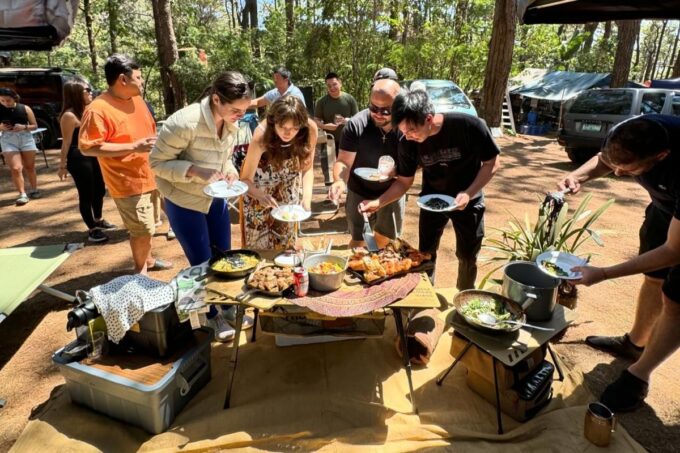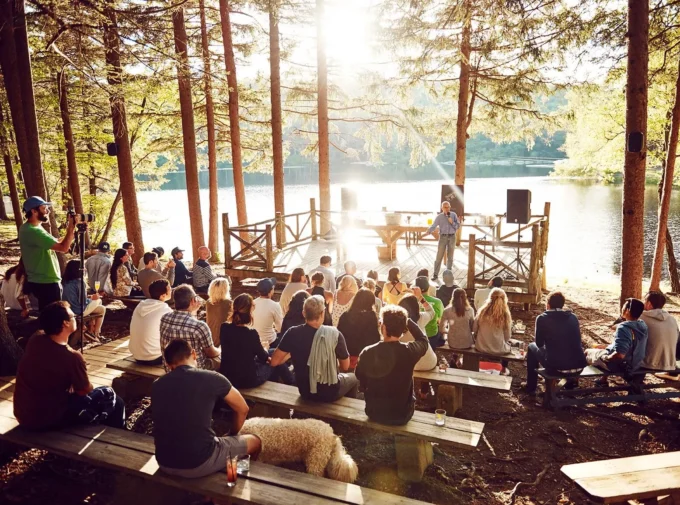Something’s changing in how companies recharge their people, and it’s not about lavish hotels or posh conference centers anymore. For years, the standard company retreat followed a formula: gather everyone in a resort, schedule a few workshops, have a team dinner, and call it bonding.
But lately, more teams are swapping boardrooms for bonfires, and the retreat game is taking a turn. This shift isn’t about being trendy ─ it’s about getting real with what people need. Connection, breathing room, and a reminder that we’re human before we’re employees. Nature’s stepping in as the new boardroom, and it’s working better than anyone expected.
Teams Don’t Want Polished Anymore ─ They Want Real
It’s become clear that people are craving something more genuine. They’ve been through a lot in the past few years ─ burnout, isolation, non-stop Zooms ─ and the last thing anyone wants is a retreat that feels like another corporate checkbox. More teams are choosing to gather off-grid, in places where the Wi-Fi signal flickers and nobody’s expected to wear a name tag. These aren’t anti-work getaways ─ they’re actually making teams work better by giving people space to step out of their roles and reconnect as humans.
That’s why fire pits and canvas tents are popping up more often than projectors and banquet tables. The vibe is different when you’re waking up to birds instead of an alarm, and your meeting happens around a picnic table instead of inside a stuffy conference hall. People are cooking together, talking without laptops in front of them, and laughing more often. A well-stocked outdoor cooking kit becomes a centerpiece, not an afterthought ─ meals prepared side-by-side become a kind of teamwork nobody planned, but everyone remembers. It’s not just downtime. It’s a total reset, and it sticks.

The Outdoors Aren’t Just Pretty ─ They’re Productive
There’s something interesting about working in the open air that no spreadsheet can really explain. When people aren’t staring at fluorescent lights or clock-watching, their conversations change. Ideas land softer. Disagreements don’t feel as sharp. And collaboration starts to feel like something you actually want to do, instead of something you’re supposed to do. That’s the magic of space and movement. Walk-and-talks replace stale sit-downs. Midday hikes shake up creative blocks. Nobody cares if you’re in sneakers or if your hair’s messy. The pressure drops and the real stuff rises.
A lot of retreat planners are building in more time for quiet reflection, solo journaling, or even casual one-on-ones while walking through woods or sitting near water. It sounds small, but the ripple effect is big. The way someone opens up when they’re next to a campfire isn’t the same as when they’re across from you in a glass-walled meeting room. And when you add in shared physical challenges ─ like trail hikes or kayaking ─ it becomes clear who leads with calm and who encourages the slowest team member. These aren’t exercises in trust falls. They’re real-world snapshots of how people show up, and they leave a lasting impression that carries back into the office.

Leadership Feels Different At A Mountain Retreat
One of the biggest surprises leaders are finding is how much their role shifts once they’re outside the office. Without a desk or title hovering above them, the playing field flattens. Suddenly, the CEO is just another person trying to start a campfire or make pancakes on a windy morning. The power dynamics change in subtle but meaningful ways, and that shift in energy can have long-lasting effects.
At a mountain retreat, conversations feel more open, especially when leaders are willing to show up without a script. Vulnerability becomes a strength rather than something to avoid, and it shows teams that authenticity isn’t just encouraged ─ it’s expected. That kind of leadership presence is hard to teach in a conference seminar. But give someone a weekend without cell service, a few moments of shared effort, and a starlit sky, and it starts to come naturally. The retreat becomes less about “leading” and more about modeling a kind of humanity that’s deeply magnetic.

People Remember Feelings More Than Agendas
What makes these new-style retreats stick is the emotional imprint they leave behind. People might forget the list of goals set during the trip, but they’ll remember how it felt to laugh uncontrollably during a group cooking mishap or to sit in silence next to a teammate watching a sunrise. These small, in-between moments matter more than the itinerary, and they end up creating stronger bonds than any structured icebreaker ever could.
There’s also something about physical effort ─ moving your body, breathing fresh air, being a little uncomfortable ─ that brings people into the present moment. Phones get tucked away. Attention gets sharper. And slowly, that mental fog that hangs over so many office dynamics starts to lift. When teams return, they often carry with them a sense of “we’ve been through something” that subtly changes how they communicate, how they collaborate, and how much grace they give each other.

It’s Not About Escape ─ It’s About Reconnection
Retreats that bring people into nature aren’t just trying to offer a break from work ─ they’re giving teams a new way to understand what work can feel like when the pressure is off and the connection is real. It’s not escapism. It’s clear. When the structure of a traditional office fades away, what’s left behind is often stronger, wiser, and more human than what went in.
These retreats aren’t a trend. They’re a course correction. And the companies paying attention aren’t asking, “What’s the ROI?” They’re asking, “How can we help our people feel whole again?”
Sometimes, the smartest move a company can make isn’t a strategy ─ it’s a weekend under the stars.






